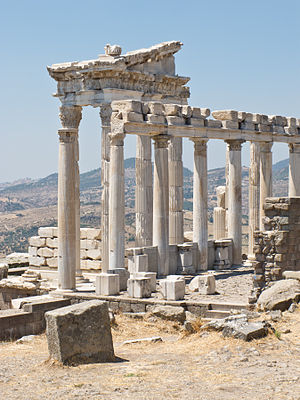Pergamum
φιλοτιμία καλεῖ τέχν' ὑπερόντα κτλ. → ambition for honor is calling superior sons ... (Inscription on church wall, Constantinople)
English > Greek (Woodhouse)
Citadel of Troy: Πέργαμον, τό, or pl.; see Troy.
Pergamum (town): Πέργαμον, τό. Sometimes Πέργαμος, ἡ (Xen., Hell. III, I 6).
of Pergamum, adj.: Περγαμηνός.
Latin > English (Lewis & Short)
Pergămum: i, n.,
I a city in Creta, founded by Agamemnon (or acc. to Verg. A. 3, 133, by Æneas), Vell. 1, 1, 2.
Pergămum: i, n.,
I a city in Mysia, on the Caystrus, the residence of the Attalian kings, with a celebrated library, now Bergamo, Plin. 5, 30, 33, § 126; Liv. 29, 11; 37, 19; 20 al.—Hence,
A Pergămēnus, a, um, adj., = Περγαμηνός, of or belonging to Pergamum in Mysia, Pergamean: Pergamena civitas, Cic. Fl. 30, 64: ager, Liv. 37, 21: naves, Nep. Hann. 11, 5.—Pergamena charta, or as subst.: Pergămēna (collat. form Pergămīna, Not. Tir. p. 124), ae, f., parchment, a material for writing on, prepared from the skins of animals, invented by Eumenes, king of Pergamum, Isid. Orig. 6, 11; Hier. Ep. 7, n. 2; cf. Varr. ap. Plin. 13, 11, 21, § 70.—Pergămēna, ae, f., the country about Pergamum, Plin. 5, 30, 33, § 126.—In plur.: Pergămēni, ōrum, m., the inhabitants of Pergamum, the Pergameans, Cic. Fl. 30, 74.—
B Pergămĕ-us, a, um, adj., of or belonging to the city of Pergamum, Pergamean (poet.): deus, i. e. Æsculapius (who was worshipped at Pergamum), Mart. 9, 17, 2.
Pergămum: i, n., v. Pergama.
Latin > French (Gaffiot 2016)
Pergămum,¹³ ī, n.,
1 v. Pergama
2 v. de la Grande Mysie, qui fut capitale du royaume de Pergame et résidence des rois Attale : Plin. 5, 126 ; Liv. 27, 19, 1 ; 29, 11, 7 ; 37, 20, 8 || -mēnus, a, um, de Pergame : Cic. Fl. 64 ; Liv. 37, 21 ; v. Pergamena 2 ; -mēnī Cic. Fl. 74, habitants de Pergame || ou -mĕus, a, um Mart. 9, 16, 2, de Pergame
3 v. de Crète [fondée par Énée : Virg. En. 3, 133 ] : Vell. 1, 1, 2.
Latin > German (Georges)
Pergamum, ī, n. u. Pergamus u. Pergamos, ī, f. (Πέργαμον u. Πέργαμος), eig. jede Burg od. Anhöhe; dah. I) die Burg von Troja (bei Hom. ἡ Πέργαμος, bei Spät. το Πέργαμον u. Plur. τὰ Πέργαμα), Sing. neutr., Sen. Agam. 421 (442); Troad. 14: Sing. fem., Troiana Pergamus, Stat. silv. 1, 4, 100. – gew. Plur., Pergama, ōrum, n., Lucr. 1, 476. Verg. Aen. 1, 651. Ov. met. 13, 374: Form Pergamos, Stat. silv. 3, 4, 68 u. 106. Auct. Aetnae 18. – II) Stadt in Großmysien am Flusse Kaikus (mit dem sich hier der mitten durch die Stadt fließende Selinus und der ihre Mauern bespülende Cetius vereinigen), später Hauptstadt des pergamenischen Reiches, berühmt durch eine große Bibliothek u. durch die Erfindung des Pergamentes, j. Bergama, Nom. -um, Plin. 5, 126: Genet., Liv. 37, 20, 8. Plin. 13, 70: Akk., Liv. 29, 11, 7: Abl., Liv. 27, 19, 1. – Dav.: A) Pergamēnus, a, um (Περγαμηνός), zu Pergamum (in Mysien) gehörig, pergamenisch, ager, Liv.: naves, Nep.: civitas, Cic. – subst., a) pergamēna, ae, f. (sc. charta), Pergament, Isid. orig. 6, 11, 1. Not. Tir. 76, 25 (wo pergamina). – b) Pergamēnī, ōrum, m., die Einwohner von Pergamum, die Pergamener, Cic. u. Nep. – B) Pergameus, a, um (Περγάμιος), a) zur Burg Pergamus-, zu Troja gehörig, pergamisch, trojanisch, arces, Verg.: vates, Kassandra, Prop. – poet. = römisch (weil die Römer ihre Abkunft von den Trojanern herleiteten), Sil. 1, 47. – b) zur Stadt Pergamum (in Mysien) gehörig, pergamisch, deus, der (zu P. verehrte) Äskulap, Mart. 9, 16, 2.
Wikipedia EN
Pergamon or Pergamum (/ˈpɜːrɡəmən/ or /ˈpɜːrɡəmɒn/; Ancient Greek: Πέργαμον), also referred to by its modern Greek form Pergamos (Greek: Πέργαμος), was a rich and powerful ancient Greek city in Mysia. It is located 26 kilometres (16 mi) from the modern coastline of the Aegean Sea on a promontory on the north side of the river Caicus (modern-day Bakırçay) and northwest of the modern city of Bergama, Turkey.
During the Hellenistic period, it became the capital of the Kingdom of Pergamon under the Attalid dynasty in 281–133 BC, who transformed it into one of the major cultural centres of the Greek world. Many remains of its impressive monuments can still be seen and especially the outstanding masterpiece of the Pergamon Altar. Pergamon was the northernmost of the seven churches of Asia cited in the New Testament Book of Revelation.
The city is centered around a 335-metre-high (1,099 ft) mesa of andesite which formed its acropolis. This mesa falls away sharply on the north, west, and east sides, but three natural terraces on the south side provide a route up to the top. To the west of the acropolis, the Selinus River (modern Bergamaçay) flows through the city, while the Ketios river (modern Kestelçay) passes by to the east.
Translations
af: Pergamum; als: Pergamon; ar: بيرغامون; ast: Pérgamo; az: Perqam; be_x_old: Пэргам; be: Пергам; bg: Пергам; br: Pergamon; ca: Pèrgam; ceb: Bergama; cs: Pergamon; cy: Pergamon; da: Pergamon; de: Pergamon; el: Πέργαμος; en: Pergamon; eo: Pergamo; es: Pérgamo; et: Pergamon; eu: Pergamo; fa: پرگامون; fi: Pergamon; fr: Pergame; ga: Péargamon; gl: Pérgamo; he: פרגמון; hr: Pergam; hu: Pergamon; hy: Պերգամոն; ia: Pergamon; id: Pergamum; is: Pergamon; it: Pergamo; ja: ペルガモン; ka: პერგამონი; kk: Пергам; ko: 페르가몬; la: Pergamum; lt: Pergamas; lv: Pergama; ms: Pergamon; nl: Pergamon; nn: Pergamon; no: Pergamon; oc: Pergam; pl: Pergamon; pt: Pérgamo; ro: Pergam; ru: Пергам; scn: Pergamu; sco: Pergamon; sh: Pergam; sk: Pergamon; sl: Pergamon; sr: Pergam; sv: Pergamon; sw: Pergamon; tl: Pergamo; tr: Pergamon; uk: Пергам; ur: پیرگامون; vi: Pergamon; war: Pergamon; zh: 帕加马

